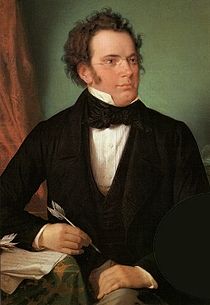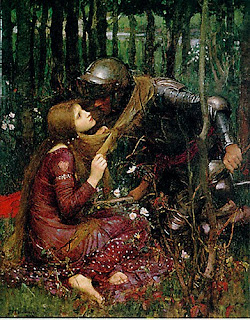 |
| Franz Schubert. Portrait by Wilhelm August Rieder |
1) Symphony in B Minor ("Unfinished")
From its tremolo opening to the noble theme, sung forth in the cellos, this two-movement torso features everything that makes a Schubert work great: powerful, innovative use of modulation, and above all melodies that at first soothe and ultimately end on a disquieting, unfinished note. Schubert sketched a third movement, and may have planned a fourth, but the Unfinished stands as a masterpiece.
2) Der Doppelganger
Many of Schubert's best songs are horror stories in miniature. Schubert's second-to-last lied explores psychological horror: the idea of having to confront your own duplicate--and your own madness.
3) Erlkönig
With its difficult, galloping piano part, this song about a father trying to save his child from a demonic figure (the "Erl King") is one of Schubert's most popular Lieder. The singer has to play four parts: the narrator, father the terrified child, and the wheedling, seductive Erl King. All this in four minutes.
4) Der Wanderer
This soul-searching ballad is one of the most famous Schubert songs, from its introspective opening recitative, to the introduction of a lilting, almost gleeful 6/8 figure in the second half that brings the work to a climax. It also served as the launch-point for the later "Wanderer Fantasy", one of the composer's famous piano works.
5) String Quartet No. 12: Quartettsatz
Schubert spent much of his brief career pushing the boundaries of form in chamber music. (Often he would do so by simply not finishing works.) This is the first movement from the never-completed String Quartet No. 12. It stands on its own, especially with its warm, harmonized second subject. Premiered after the composer's death.
6) String Quintet in C Major D. 956
The best "gateway" to the music of Schubert is this exquisite, melancholy quintet that (unusually) replaces the traditional second viola with a second 'cello--allowing the two low instruments to interweave and comment on each other's basslines as the violins duel in the upper register. Genius.
7) Der Winterreise
The most famous song cycle ever written. The hero, rejected by his lover, begins a trek into white oblivion, slowly going mad in the freezing dead of winter over the course of 24 songs. Winterreise broke fresh ground when it premiered, and its narrative never fails to chill one to the marrow.
8) Piano Sonata No. 6 in E Minor
Like many Schubert works, this piano sonata shifts moods as it develops. An up-tempo opening gives way to the suffering brooding beneath the surface. Schubert wrote 21 sonatas. His work does not have storm and fire of Beethoven or the dazzling virtuososity of Liszt. But it has endured through the emotional, melodic nature of the music which speaks to listeners 200 years later.
9) Nachtgesang im Walde
Written for four horns and a male chorus, this short part-song is one of Schubert's fine examples of secular choral writing. The opening evokes the mystery of the woods at night, and the later pages shift to celebratory hunting music. The combination of chorus, nature images and mysterious minor chords points the way forward to Mahler.
10) Impromptu No. 2 in E Flat
This work opens rolling wave of arpeggiated notes displays Schubert the consumnate pianist. It requires fluid legato playing and a dexterous technique. Once the main theme arrives, the swift passage becomes expert accompaniment to the noble main theme. Played by the right pianist, the effect of this demanding piece is breathtaking.






















